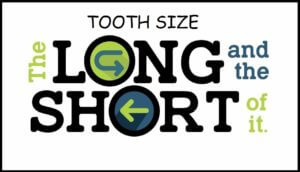Does it ever seem that your tooth size is longer or shorter than it was when you were younger? In this article, we explore the various reasons and causes of the changes in our tooth size.
Do our teeth get longer as we age?
There is an expression that I don’t hear that often anymore. The idiom is “long in the tooth.” This phrase is usually referring to someone getting older. It is based on the thought that teeth grow longer as we age.
Well, this is true when we are children and teens. As teeth start to come in or erupt, as we term it in dentistry, they appear to be growing.
They are not growing. In fact, when teeth are developing in the gums as children, they are adult size. As we get into our teen years, the teeth grow into the mouth. It appears that they are growing bigger, but in reality, they are just uncovering themselves from the gum tissue from which they were buried.
Less gum tissue = longer teeth
Teeth, for the most part, do not grow or move anymore once we reach our late teens. However, with time, gum tissues may shrink away from the tooth.
Sometimes, we become very hard brushers and wear away our gum tissue. Gum tissue is fragile right around the tooth and can be easily brushed away. Now we see more enamel than we saw previously.
Other times, due to gum disease, a shrinkage of gum tissue may occur. This reduction happens as bacteria destroy the underlying bone and there is nothing to support the gum tissue.
In any of these cases, we see more tooth enamel. Making it appear that our teeth are longer than before. This condition occurs because more tooth is exposed above the gum line than what we may have observed in previous years.
Okay, I get it. As we get older, and our gums shrink, our teeth “appear” to get longer than they were in our youth. That’s what the idiom, “long in the tooth” means.
Why Are My Teeth So Short?
But wait! As we age, many of us see our teeth shorten. This phenomenon isn’t supposed to happen, is it? Well if the gum does not shrink away from the tooth, then the pseudo-growing phenomenon will not occur. That explains lack of getting bigger, but where does the shortness come from?
Are the teeth shorter or do they just appear that way?
Does it fool us as the tooth growing act fools us?
Our teeth DO shrink!
In reality, the teeth get shorter. It is not an optical illusion. The more we chew, the more our teeth wear.
Teeth are the hardest tissue in the body. They are denser than bone. It needs to be this hard as it is the first tissue encountered during the eating process. It needs to be very dense as it tears and grinds at food.
Ah, there is the answer to your question. We use our teeth to grind.
With modern dental care and a better understanding of what causes disease, we can keep our teeth for many years longer than previous generations. Because of this, we grind more food for more years. Over time, our teeth slowly wear away. If we are missing teeth, then the remaining ones work harder, grind more and end up wearing away more. This is how we get short teeth.
This condition is even more noticeable in the front of our mouths. Let me explain why this is so. The patient who asked me that question had their upper front teeth meet their lower front teeth. The teeth touched each other tip to tip. In dentistry, we call it “edge to edge.” Every time they chewed their food, not only did their back teeth grind, but their front teeth were grinding too.
Sounds great. After all, more teeth grinding is more efficient -right? Wrong!
The problem stems from the fact that the front teeth are narrow-edged. They are designed to tear, not to crush. When we use them to grind, they wear away very quickly. Grinding with our incisors creates short teeth and a loss of healthy cosmetics.
We identified the problems. Any solutions?
How do we fix this issue? I will give you some answers in our next column. Until then, if things are starting to change in your mouth and just don’t look right, please give me a call and ask me a question. I will do my best to help you. You can reach me at 440.951.7856
Jeffrey Gross, DDS, FAGD, is an Ohio-licensed general dentist and is on the staff of Case Western Reserve School of Dental Medicine.

